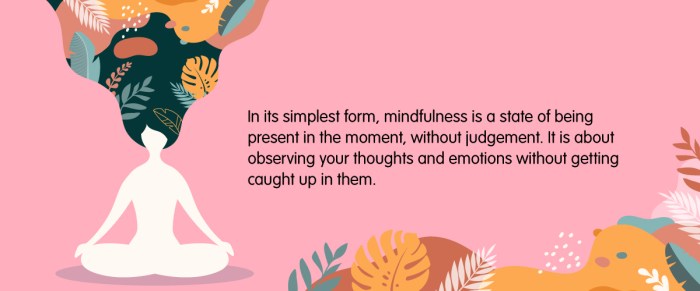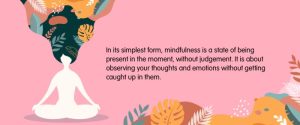
Ladies, are you ready to unlock the incredible power of mindfulness to boost your physical and mental well-being? This isn’t your grandma’s relaxation technique; we’re diving deep into how mindfulness can specifically address the unique health challenges women face, from PMS to menopause and beyond. Get ready to discover practical strategies, empowering techniques, and a whole new level of self-care tailored just for you!
We’ll explore how mindfulness can help navigate the complexities of hormonal changes, stress management, and even fertility journeys. Think of it as your personal guide to a healthier, happier, and more empowered you. We’ll cover everything from simple mindful movements to guided meditations designed to help you connect with your body and mind on a deeper level. Prepare to be amazed by the transformative potential of this ancient practice in a modern context.
Mindfulness Techniques for Women’s Physical Health
Mindfulness, the practice of paying attention to the present moment without judgment, offers a powerful toolkit for managing the physical and emotional challenges women face throughout their lives. By cultivating awareness of bodily sensations, thoughts, and emotions, women can gain a deeper understanding of their health and develop effective coping strategies for various conditions. This section explores several mindfulness techniques specifically beneficial for women’s physical well-being.
Mindfulness Practices for Managing Stress Related to Women’s Health
Stress significantly exacerbates many women’s health issues, from PMS to menopause. The following table details three mindfulness practices that can help manage this stress:
| Technique | Description | Benefits | Potential Challenges |
|---|---|---|---|
| Body Scan Meditation | A guided meditation where you systematically bring awareness to different parts of your body, noticing sensations without judgment. | Reduces muscle tension, increases body awareness, helps identify physical manifestations of stress, promotes relaxation. | May require practice to quiet the mind; some individuals might find it difficult to focus initially. |
| Mindful Breathing | Paying close attention to the sensation of your breath entering and leaving your body. You can focus on the rise and fall of your abdomen or chest, or the coolness of the air entering your nostrils. | Calms the nervous system, reduces anxiety and racing thoughts, anchors you to the present moment, helps regulate emotions. | Mind can wander; requires patience and consistent practice to deepen the experience. |
| Loving-Kindness Meditation | Cultivating feelings of compassion and kindness, first towards oneself, then extending it to others. This involves silently repeating phrases like “May I be well,” “May I be peaceful,” and then extending these wishes to loved ones, strangers, and even difficult people. | Reduces feelings of isolation and self-criticism, fosters self-compassion, promotes emotional regulation, reduces stress hormones. | May feel awkward or challenging initially; requires openness and willingness to embrace compassion. |
Mindful Movement for Women’s Physical Well-being
Mindful movement, such as yoga and tai chi, combines physical exercise with mindful awareness. By focusing on the present moment during movement, women can improve physical well-being, reduce stress, and enhance body awareness. The benefits extend beyond physical fitness; they contribute to mental clarity and emotional balance.
Here is a short sequence of mindful movements suitable for beginners:
- Mindful Breathing (3 minutes): Find a comfortable seated or lying position. Close your eyes gently and bring your attention to your breath. Notice the sensation of the air entering and leaving your body. If your mind wanders, gently guide it back to your breath.
- Gentle Neck Rolls (1 minute): Slowly roll your head clockwise, then counter-clockwise, paying attention to the sensations in your neck and shoulders. Maintain a slow and controlled pace.
- Shoulder Stretches (1 minute): Gently roll your shoulders forward and backward, noticing any tension or stiffness. Let your shoulders relax with each movement.
- Cat-Cow Pose (2 minutes): Start on your hands and knees. Inhale, drop your belly towards the floor, and lift your chest (Cow Pose). Exhale, round your spine towards the ceiling, tucking your chin to your chest (Cat Pose). Repeat several times, focusing on the movement and your breath.
- Child’s Pose (1 minute): Sit back on your heels and fold forward, resting your forehead on the floor. Let your arms rest alongside your body. Breathe deeply and feel the stretch in your back and shoulders.
- Mindful Breathing (3 minutes): Return to mindful breathing, noticing the sensations in your body and the stillness of your mind.
Comparison of MBSR and MBCT for Alleviating Physical Symptoms
Mindfulness-Based Stress Reduction (MBSR) and Mindfulness-Based Cognitive Therapy (MBCT) are both evidence-based programs that utilize mindfulness techniques to address various health conditions. While both can alleviate physical symptoms associated with women’s health conditions, they differ in their approach. MBSR primarily focuses on cultivating mindfulness skills to manage stress and improve overall well-being. MBCT, on the other hand, integrates mindfulness practices with cognitive therapy techniques to help individuals identify and modify unhelpful thought patterns that contribute to stress and physical symptoms.
Studies suggest both MBSR and MBCT are effective in reducing pain, improving sleep quality, and managing symptoms related to conditions like PMS and menopause; however, MBCT may be particularly beneficial for individuals prone to rumination or negative thought patterns. The choice between MBSR and MBCT depends on individual needs and preferences, and a consultation with a healthcare professional is advisable.
Mindfulness and Mental Well-being in Women

Mindfulness, the practice of paying attention to the present moment without judgment, offers a powerful pathway to improved mental well-being for women. The stresses and demands of modern life, coupled with unique societal pressures and biological factors, can significantly impact women’s mental health. Mindfulness provides a valuable toolkit to navigate these challenges and cultivate inner resilience. By cultivating awareness of thoughts, feelings, and bodily sensations, women can gain a sense of control and calm amidst the storm.
Mindfulness acts as a buffer against the negative impacts of stress, anxiety, and depression, which are disproportionately prevalent in women. Instead of being swept away by racing thoughts or overwhelming emotions, mindfulness encourages a gentler, more compassionate approach. It helps to create space between a woman and her difficult emotions, allowing for a more objective perspective and reducing the intensity of negative thought patterns.
This shift in perspective, from being entangled in negative thoughts to observing them from a distance, can be transformative.
Mindfulness Techniques for Anxiety and Depression in Women
Many women experience anxiety and depression, often intertwined with hormonal fluctuations, life transitions, and societal expectations. Mindfulness practices offer effective tools to manage these challenges. The following points illustrate how mindfulness can be incorporated into daily life to promote mental well-being.
- Mindful Breathing: Simple yet powerful, focusing on the breath anchors us to the present moment. When anxiety arises, taking slow, deep breaths can calm the nervous system and reduce racing thoughts. For example, during a stressful work meeting, pausing to take three deep breaths can help center oneself and respond more effectively.
- Body Scan Meditation: This practice involves systematically bringing awareness to different parts of the body, noticing sensations without judgment. This can help to release physical tension often associated with anxiety and depression. Imagine, for instance, noticing the tension in your shoulders after a long day and consciously relaxing them, breath by breath.
- Mindful Movement: Engaging in activities like yoga or tai chi, while paying attention to the body’s movements and sensations, can help to ground us and reduce feelings of overwhelm. For example, a mindful walk in nature, paying attention to the feeling of the ground beneath your feet and the sun on your skin, can be incredibly soothing.
Three Common Mental Health Challenges and Mindfulness Solutions
Women face a unique set of mental health challenges. Mindfulness offers a supportive approach to address these issues.
- Postpartum Depression (PPD): The hormonal shifts and life changes after childbirth can trigger PPD. Mindfulness practices like mindful breathing and self-compassion meditations can help manage overwhelming emotions and cultivate self-acceptance during this vulnerable time. A mother experiencing PPD might find solace in practicing mindful breathing while nursing her baby, focusing on the connection and present moment.
- Premenstrual Dysphoric Disorder (PMDD): PMDD is a severe form of PMS characterized by intense mood swings, irritability, and anxiety. Mindfulness techniques, such as body scan meditation and mindful self-care practices, can help women become more aware of their bodies and emotional patterns, allowing them to manage symptoms more effectively. For example, noticing the physical sensations associated with PMDD and practicing self-compassion can reduce the intensity of emotional distress.
- Stress and Burnout: Women often juggle multiple roles (work, family, relationships), leading to chronic stress and burnout. Mindfulness practices, such as mindful walking and meditation, can help women manage stress levels and improve their ability to cope with daily demands. A woman feeling overwhelmed by work and family responsibilities could incorporate short mindfulness breaks throughout the day to regain focus and reduce feelings of being overwhelmed.
Guided Meditation for Self-Compassion and Body Awareness
Find a comfortable position, either sitting or lying down. Close your eyes gently. Bring your attention to your breath, noticing the natural rhythm of your inhales and exhales. Allow your body to relax, releasing any tension you may be holding.
Now, bring your awareness to your body. Notice any sensations – tightness, warmth, coolness, tingling. Acknowledge these sensations without judgment. Simply observe them. Imagine a warm, gentle light surrounding your body, filling you with a sense of peace and acceptance.
Repeat silently to yourself: “I am worthy of love and kindness. I am enough, just as I am. I accept myself completely.” Let these words soothe and comfort you. Feel the warmth of self-compassion spreading throughout your body.
Continue to breathe deeply, allowing the feeling of self-compassion to deepen. Take your time. There is no rush. When you are ready, gently bring your awareness back to the room, wiggling your fingers and toes. Open your eyes slowly, carrying this feeling of self-compassion with you throughout your day.
Mindfulness for Specific Women’s Health Concerns

Mindfulness, the practice of paying attention to the present moment without judgment, offers a powerful tool for navigating the unique challenges women face throughout their lives. This section explores how mindfulness techniques can be specifically applied to address the symptoms and emotional distress associated with various stages and health concerns. By cultivating awareness and acceptance, women can find greater ease and resilience in managing these experiences.
Mindfulness and Perimenopause/Menopause
Perimenopause and menopause, characterized by hormonal fluctuations, can bring a cascade of physical and emotional symptoms. Mindfulness practices can provide a valuable coping mechanism. For example, during a hot flash, instead of resisting the sensation, a woman can practice mindful observation, noticing the heat rising in her body, the changes in her skin, and the accompanying sensations without judgment.
This mindful awareness can help reduce the intensity of the experience and lessen the accompanying anxiety. Similarly, mindfulness meditation can improve sleep quality by focusing on the breath and releasing racing thoughts that often interfere with sleep. For mood swings, mindfulness encourages self-compassion and acceptance of fluctuating emotions. By observing these emotions without judgment, a woman can reduce reactivity and cultivate a more balanced emotional state.
Regular mindfulness practice, including body scans and mindful movement, can help manage the overall physical and emotional impact of this life stage.
Mindfulness and Fertility Challenges
The journey to conception can be emotionally taxing, especially when facing infertility or undergoing IVF treatments. Mindfulness offers a path to manage stress and cultivate hope.Mindfulness techniques can offer valuable support during this challenging time. These practices help women develop coping strategies for managing stress and emotional distress.
- Mindful breathing exercises can calm the nervous system and reduce anxiety before and during medical procedures.
- Body scan meditations can increase body awareness and help release physical tension associated with stress.
- Guided imagery can promote relaxation and visualization of a successful outcome.
- Journaling can provide an outlet for processing emotions and tracking progress.
- Mindful self-compassion practices can help women accept and manage difficult emotions without self-criticism.
After experiencing pregnancy loss, mindfulness can help women process grief and trauma in a healthy way, fostering self-compassion and acceptance of their experience. It provides a space for gentle exploration of emotions without judgment, supporting healing and emotional recovery.
Mindfulness and Postpartum Recovery
The postpartum period is a significant transition, encompassing both physical and emotional adjustments. Mindfulness practices can support women in navigating this complex phase.
| Stage of Postpartum | Mindfulness Technique | Benefits | Cautions |
|---|---|---|---|
| Early Postpartum (first 6 weeks) | Mindful breathing, body scans focusing on pelvic floor | Reduces pain, promotes relaxation, increases body awareness | Avoid strenuous practices; listen to body signals; seek professional help if experiencing severe pain or distress |
| Later Postpartum (6 weeks – 6 months) | Mindful walking, gentle yoga, mindful self-compassion | Improves mood, reduces stress, facilitates emotional regulation, promotes physical recovery | Progress gradually; avoid overexertion; prioritize rest; seek support if struggling with overwhelming emotions |
| Extended Postpartum (6 months onwards) | Mindful movement, meditation, gratitude practices | Enhances self-care, fosters resilience, supports long-term well-being | Continue to listen to body signals; adjust practices as needed; seek professional support if needed |
Integrating Mindfulness into Daily Life for Women’s Health
Mindfulness, the practice of paying attention to the present moment without judgment, offers incredible benefits for women’s health, encompassing physical, mental, and emotional well-being. However, integrating this practice into the often-hectic lives of modern women requires a strategic and compassionate approach. This section provides a practical plan to seamlessly weave mindfulness into your daily routine, even amidst the demands of work, family, and personal life.
A Practical Plan for Daily Mindfulness
This plan focuses on building a sustainable mindfulness practice through small, manageable steps rather than overwhelming yourself with grand gestures. The key is consistency, not intensity. Start with short sessions and gradually increase the duration as you feel comfortable. Consider incorporating mindfulness into existing routines, rather than adding entirely new ones. This minimizes disruption and maximizes adherence.
- Morning Mindfulness: Begin your day with 5-10 minutes of mindful breathing or a body scan. Focus on the sensations in your body as you wake up, noticing the feeling of your breath, the weight of your body against the bed, and any sounds around you. This sets a calm and centered tone for the day.
- Mindful Moments Throughout the Day: Schedule short mindful breaks throughout your day. These could be 1-2 minute pauses during your workday to focus on your breath, a few moments of mindful eating during lunch, or a short walk in nature where you pay attention to the sights, sounds, and smells around you. Even a few seconds of focused breathing during a stressful moment can make a difference.
- Evening Reflection: Before bed, take 5-10 minutes to reflect on your day. Consider what went well, what you learned, and what you might do differently tomorrow. This practice promotes gratitude and helps process emotions, contributing to better sleep.
- Mindful Movement: Incorporate mindfulness into physical activity. Instead of focusing on performance, pay attention to the sensations in your body as you exercise. Notice the rhythm of your breath, the movement of your muscles, and the feeling of your feet on the ground.
Overcoming Obstacles to Maintaining a Mindfulness Practice
Many women face challenges in maintaining a consistent mindfulness practice. However, understanding these obstacles and employing effective strategies can help overcome them.
- Time Constraints: The most common obstacle is lack of time. The solution is to prioritize mindfulness by scheduling it into your day like any other important appointment. Start small, even with 1-minute mindful breathing sessions. These short sessions add up over time and create a sense of accomplishment, motivating you to continue.
- Lack of Motivation: Motivation can fluctuate. To counteract this, find a mindfulness practice you genuinely enjoy. Experiment with different techniques – guided meditations, body scans, mindful walking – until you find what resonates with you. Remember the benefits you experience, and remind yourself why you started.
- Distractions: Life is full of distractions. Acknowledge them without judgment and gently redirect your attention back to your breath or the present moment. Create a dedicated space for mindfulness practice, minimizing distractions as much as possible. Consider using a meditation app with calming sounds to help block out external noise.
Creating a Supportive Environment for Mindfulness
A supportive environment is crucial for a successful mindfulness practice. This involves consciously creating spaces at home and work that foster calmness and focus.
At home, designate a quiet corner or room as your mindfulness space. Keep it clutter-free and inviting. Consider incorporating elements that promote relaxation, such as soft lighting, calming colors, comfortable seating, and perhaps aromatherapy. At work, find a quiet space where you can take short breaks for mindfulness. This could be an empty meeting room, a quiet corner of the office, or even your car during your lunch break.
Minimize distractions by turning off notifications on your phone and creating a mental boundary to protect your mindfulness time.
Women & Health
Navigating the healthcare system and prioritizing well-being presents unique challenges for women, often intertwined with societal expectations and systemic barriers. Understanding these complexities is crucial for empowering women to take control of their health journeys. This section explores the broader landscape of women’s health, examining the obstacles faced and the role mindfulness plays in overcoming them.
Women frequently experience disparities in healthcare access and quality compared to men. These disparities stem from a complex interplay of factors, including financial limitations, geographical location, implicit bias within the medical system, and a lack of research specifically focusing on women’s health issues. Societal pressures, such as the expectation to prioritize others’ needs over their own, can further exacerbate these challenges, leading to delayed or forgone healthcare.
The underrepresentation of women in clinical trials also means treatments and diagnoses may not be as effective or accurate for women as they are for men.
Mindfulness as a Tool for Health Advocacy
Mindfulness practices can equip women with the tools necessary to navigate these complex systems effectively. By cultivating self-awareness, women can better identify their health needs and communicate them clearly to healthcare providers. This includes assertively voicing concerns, asking clarifying questions, and advocating for appropriate testing and treatment. For example, a woman experiencing persistent pain might use mindfulness techniques to stay grounded and articulate her symptoms with precision during a doctor’s appointment, rather than feeling dismissed or overwhelmed.
The ability to remain present and focused, cultivated through mindfulness, can empower women to make informed decisions about their healthcare, ensuring their voices are heard and their needs are met.
Mindfulness, Gender Equality, and Health Outcomes
The relationship between mindfulness, gender equality, and women’s health outcomes is deeply interconnected. Gender inequality creates and perpetuates many of the systemic barriers women face in accessing healthcare. Mindfulness, by fostering self-compassion and reducing stress, can mitigate the negative impact of these inequalities on women’s physical and mental well-being. For instance, a woman facing discrimination in the workplace might use mindfulness techniques to manage stress and prevent burnout, ultimately protecting her physical and mental health.
Furthermore, promoting mindfulness practices within communities can contribute to a culture of self-care and empowerment, fostering a more equitable environment where women’s health concerns are prioritized and addressed effectively. Investing in accessible mindfulness programs for women, especially those from marginalized communities, is a crucial step towards achieving better health equity.
Final Summary
By incorporating mindfulness into your daily life, you’re not just treating symptoms; you’re cultivating a holistic approach to wellness that empowers you to take charge of your health. From managing stress and anxiety to navigating the physical and emotional changes of life’s different stages, mindfulness offers a powerful toolkit for self-care and self-discovery. Remember, this journey is about nurturing yourself, honoring your body, and celebrating your strength.
Embrace the power of mindfulness – your body and mind will thank you!
FAQ
Can mindfulness cure specific health conditions?
Mindfulness isn’t a cure-all, but it’s a powerful tool to manage symptoms and improve overall well-being by reducing stress and enhancing self-awareness. It’s best used alongside conventional medical treatments.
How long does it take to see results from mindfulness practice?
It varies from person to person. Some experience benefits immediately, while others may notice changes over several weeks or months of consistent practice. Consistency is key!
Is mindfulness right for everyone?
While generally beneficial, individuals with certain mental health conditions might need to approach mindfulness with guidance from a healthcare professional. It’s always a good idea to consult your doctor before starting any new practice.
What if I don’t have much time for mindfulness?
Even short, 5-10 minute sessions can be effective. Start small and gradually increase the duration as you become more comfortable.





